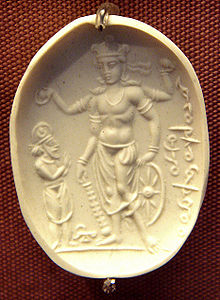Huna people: Difference between revisions
irrelevant to this article |
look at Huna Kingdom & Xionites |
||
| Line 12: | Line 12: | ||
[[File:VishnuGandhara.JPG|thumb|Sardonyx seal representing Vishnu with a worshipper, Afghanistan or Pakistan, 4th to 6th centuries CE. The inscription in cursive [[Bactrian language|Bactrian]] reads: "[[Mihira]] ([[Mihirakula]]?), [[Vishnu]] and [[Shiva]]". [[British Museum]].]] |
[[File:VishnuGandhara.JPG|thumb|Sardonyx seal representing Vishnu with a worshipper, Afghanistan or Pakistan, 4th to 6th centuries CE. The inscription in cursive [[Bactrian language|Bactrian]] reads: "[[Mihira]] ([[Mihirakula]]?), [[Vishnu]] and [[Shiva]]". [[British Museum]].]] |
||
The '''Hunas''' were |
The '''Hunas''' were [[Xionites|Xionite]] tribes who, via [[Khyber Pass]], entered India at the end of the 5th or early 6th century and were defeated by the Indian [[Gupta Empire]] and the Indian king [[Yasodharman]].<ref>India: A History by John Keay p.158</ref> In its farthest geographical extent in India, the Huna empire covered the region up to [[Malwa]] in central India.<ref>{{cite web |url=http://www.diss.fu-berlin.de/diss/servlets/MCRFileNodeServlet/FUDISS_derivate_000000007165/01_Text.pdf |title=The Hephthalites: Archaeological and Historical Analysis |last=Kurbanov |first=Aydogdy |page=24 |year=2010 |accessdate=17 January 2013 |quote=The Hūnas controlled an area that extended from Malwa in central India to Kashmir.}}</ref> |
||
==History== |
==History== |
||
Revision as of 00:04, 13 November 2015
This article may have misleading content. (July 2013) |
| History of Tajikistan |
|---|
| Timeline |
|
|
This article needs additional citations for verification. (March 2012) |




Obv: Napki Malka type bust, winged headdress with bull head in the center. Pahlavi legend "NAPKI MALKA".
Rev: Zoroastrian fire altar with attendants either side. Sun wheel, or possibly eight-spoked Buddhist Dharmacakra, above left.

The Hunas were Xionite tribes who, via Khyber Pass, entered India at the end of the 5th or early 6th century and were defeated by the Indian Gupta Empire and the Indian king Yasodharman.[2] In its farthest geographical extent in India, the Huna empire covered the region up to Malwa in central India.[3]
History

The Hunas initiated a coinage inspired from Sassanian designs.[4]
According to Litvinsky, the initial Huna or Alxon raids on Gandhara took place in the late 5th and early 6th century AD, upon the death of the Gupta ruler, Skandagupta (455–470), presumably led by the Tegin Khingila. M. Chakravary, based on Chinese and Persian histories believes that the Hunas conquered Gandhara from the Ki-to-lo (Kidarites) in c. 475 AD. Gandhara had been occupied by various Kidarite principalities from the early 4th century AD, but it is still a subject of debate as to whether rule was transferred from the Kidarites directly to the Hephthalites. It is known that the Huns invaded Gandhara and the Punjab from the Kabul valley after vanquishing the Kidarite principalities.

The Hunas are mentioned in the Tibetan chronicle Dpag-bsam-ljon-bzah (The Excellent Kalpa-Vrksa), along people like the Yavanas, Kambojas, Tukharas, Khaqsas, Daradas etc.[5][6]
Religion
The Hunas were fervent worshippers of the Vedic Sun God and Shiva.[7]
Sung Yun and Hui Sheng, who visited the chief of the Hephthalite nomads at his summer residence in Badakshan and later in Gandhara, observed that they had no belief in the Buddhist law and served a large number of divinities."[8]
See also
- 36 royal races
- Ancient India and Central Asia
- Hon
- History of India
- History of Central Asia
- Raghuvaṃśa
Notes
- ^ Iaroslav Lebedynsky, "Les Nomades", p172.
- ^ India: A History by John Keay p.158
- ^ Kurbanov, Aydogdy (2010). "The Hephthalites: Archaeological and Historical Analysis" (PDF). p. 24. Retrieved 17 January 2013.
The Hūnas controlled an area that extended from Malwa in central India to Kashmir.
- ^ Source
- ^ Tho-gar yul dań yabana dań Kambodza dań Khasa dań Huna dań Darta dań...
- ^ Pag-Sam-Jon-Zang (1908), I.9, Sarat Chandra Das; Ancient Kamboja, 1971, p 66, H. W. Bailey.
- ^ History of civilizations of Central Asia, Volume 3 By Boris Abramovich Litvinovskiĭ Page 173
- ^ "The White Huns - The Hephthalites". Silkroad Foundation. Retrieved 11 January 2013.
References
- Iaroslav Lebedynsky, "Les Nomades", Paris 2007, ISBN 978-2-87772-346-6
